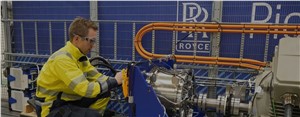Electrical Motor Technology for Regional Air Mobility Passed to Test
December 21, 2023
-The motor is a 320 kW direct-drive electric machine, specially designed for the requirements of electric commuter aircraft. These include being as lightweight as possible, compact and adaptable to different configurations as well as meeting the highest possible safety standards required in aviation. Its air-cooling system helps to reduce the system weight and complexity of the design while its four-electric-lane architecture makes it safer and more fault resistant.
Hybrid-electric and electric commuter aircraft are innovative 9- to 19-passenger aircraft with short take-off and landing capabilities. Expected to enter into commercial operation still this decade, they can be a cost-efficient answer to currently expensive business commutes, but also help to connect geographically remote or hard to reach areas, as well as supporting enhanced demand for the transportation of goods through e-commerce.
The team has now finalised the assembly of the first model of this motor design, mounted it onto a test bench and conducted its first passive test successfully. With this passive test, they can prove the basic mechanical and electrical functionality of the motor, giving us the confidence to move on to the next test steps in Munich, Germany.
In the following weeks, the motor will undergo further rigorous testing to help us validate our design assumptions and improve the design for further iterations.
A global team across five locations have been working closely together to make this success happen. While the assembly and test have taken place in Trondheim, Norway, the team that designed the motor and planned its assembly and test is spread across Germany and Hungary as well.
To enable the manufacturing of these technologies, which are not yet produced as commodities across the industry, the team were required to design some of the assembly equipment and tooling themselves, at the same time laying the groundwork for scalable production. Special machinery has also been designed and used for the insulation of the motor, delivering valuable in-house capability for the future production of highly safe electric machines.
Having control over every step of the demonstrator’s journey from design to first spin means we have full transparency over the parameters and conditions that can influence the machine during manufacturing and commissioning. This enables us to draw very accurate conclusions from our observations during testing and to make better predictions for the lifetime of the motor and its future iterations.
The team in Trondheim was able to build on their experience from the manufacturing and electric machine test of the 2 MW generator that had previously been developed for the E-Fan X project, as well as from their vast experience with electric machines for marine applications. The wider team is also incorporating learnings from previous electric machine designs like a 500 kW generator designed for the M250H project, a 400 kW electric motor designed for a Do228hep concept, and an additional 2 MW electric motor concept developed for regional aircraft.
Sigurd Øvrebø, Managing Director of Rolls-Royce Electrical Norway comments: “I want to thank the team for delivering this milestone. It’s a good example of that international team pulling on those kinds of strengths and capabilities we have in Rolls-Royce while also using this kind of local manufacturing capability that we have here in Norway to come together and deliver on time and quality on this demonstrator.”
The motor development is partially being funded by the German Federal Ministry for Economic Affairs and Climate Action.
Source : Rolls-Royce

